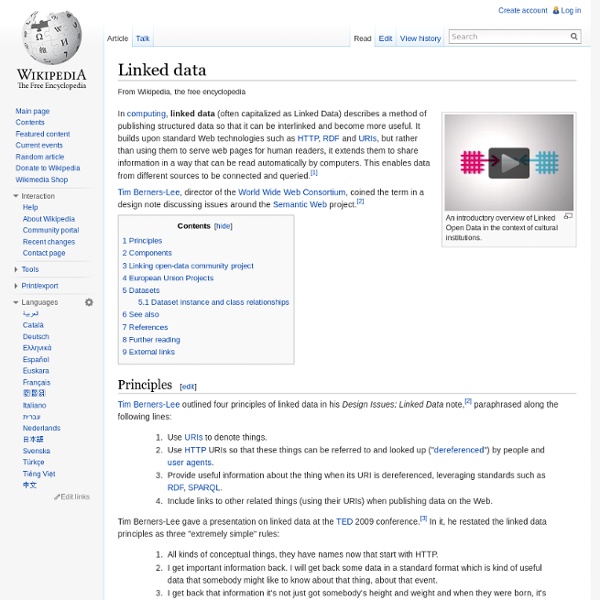TaskForces/CommunityProjects/LinkingOpenData/DataSets - ESW Wiki
SWEO Community Project: Linking Open Data on the Semantic Web This page collects RDF data sets that are part of the emerging Web of Linked Data. Please note: This page is outdated For keeping the LOD cloud diagram up to date, the Linking Open Data community effort has started to collect meta-information about Linked datasets on CKAN, a registry of open data and content packages provided by the Open Knowledge Foundation. The meta-information from CKAN (and not from this page) is used to draw the LOD cloud diagram and to maintain statistics about the size of the Web of Linked Data.
FOAF (software)
Semantic Web ontology to describe relations between people The FOAF project, which defines and extends the vocabulary of a FOAF profile, was started in 2000 by Libby Miller and Dan Brickley. It can be considered the first Social Semantic Web application,[citation needed] in that it combines RDF technology with 'social web' concerns.[clarification needed]
LinkedData - W3C Wiki
LinkedData is to spreadsheets and databases what the Web of hypertext documents is to word processor files. Use URIs as names for things Use HTTP URIs so that people can look up those names. When someone looks up a URI, provide useful information.
Linked Data - Connect Distributed Data across the
How to publish Linked Data on the Web
This document provides a tutorial on how to publish Linked Data on the Web. After a general overview of the concept of Linked Data, we describe several practical recipes for publishing information as Linked Data on the Web. This tutorial has been superseeded by the book Linked Data: Evolving the Web into a Global Data Space written by Tom Heath and Christian Bizer. This tutorial was published in 2007 and is still online for historical reasons.
File:LOD Cloud Diagram as of September 2011.png
Linked Data - Design Issues
Up to Design Issues The Semantic Web isn't just about putting data on the web. It is about making links, so that a person or machine can explore the web of data. With linked data, when you have some of it, you can find other, related, data. Like the web of hypertext, the web of data is constructed with documents on the web.
D2R Server – Publishing Relational Databases on the Semantic Web
D2R Server is a tool for publishing relational databases on the Semantic Web. It enables RDF and HTML browsers to navigate the content of the database, and allows querying the database using the SPARQL query language. It is part of the D2RQ Platform. 1. About D2R Server # D2R Server is a tool for publishing the content of relational databases on the Semantic Web, a global information space consisting of Linked Data.
SweoIG/TaskForces/CommunityProjects/LinkingOpenData - ESW Wiki
News 2014-12-03: The 8th edition of the Linked Data on the Web workshop will take place at WWW2015 in Florence, Italy. The paper submission deadline for the workshop is 15 March, 2015. 2014-09-10: An updated version of the LOD Cloud diagram has been published.
About
DBpedia is a crowd-sourced community effort to extract structured information from Wikipedia and make this information available on the Web. DBpedia allows you to ask sophisticated queries against Wikipedia, and to link the different data sets on the Web to Wikipedia data. We hope that this work will make it easier for the huge amount of information in Wikipedia to be used in some new interesting ways. Furthermore, it might inspire new mechanisms for navigating, linking, and improving the encyclopedia itself.
Derrick de Kerckhove
Derrick de Kerckhove (born 1944) is the author of The Skin of Culture and Connected Intelligence and Professor in the Department of French at the University of Toronto, Canada. He was the Director of the McLuhan Program in Culture and Technology from 1983 until 2008. In January 2007, he returned to Italy for the project and Fellowship “Rientro dei cervelli”, in the Faculty of Sociology at the University of Naples Federico II where he teaches "Sociologia della cultura digitale" and "Marketing e nuovi media". He was invited to return to the Library of Congress for another engagement in the Spring of 2008.[1] He is research supervisor for the PhD Planetary Collegium M-node[2] directed by Francesco Monico. Background[edit] De Kerckhove received his Ph.D in French Language and Literature from the University of Toronto in 1975 and a Doctorat du 3e cycle in Sociology of Art from the University of Tours (France) in 1979.
OnDemand - Open Source Collaborative Networking for Intranets an
A collaborative help system that finally gives your customers and agents the knowledge they need in real time MindTouch® is a cloud based self-service help center and a knowledge-as-a-service platform that prevents support requests and improves your existing customer support systems. For the first time, you can update and deliver product knowledge in real-time, everywhere and across all channels minimizing support requests. Track your customer behavior with web analytics and MindTouch content analytics to improve your product help content, product strategy, customer success programs and customer retention while simultaneously lowering your support costs.
The original proposal of the WWW, HTMLized
A hand conversion to HTML of the original MacWord (or Word for Mac?) document written in March 1989 and later redistributed unchanged apart from the date added in May 1990. Provided for historical interest only. The diagrams are a bit dotty, but available in versioins linked below. The text has not been changed, even to correct errors such as misnumbered figures or unfinished references.



